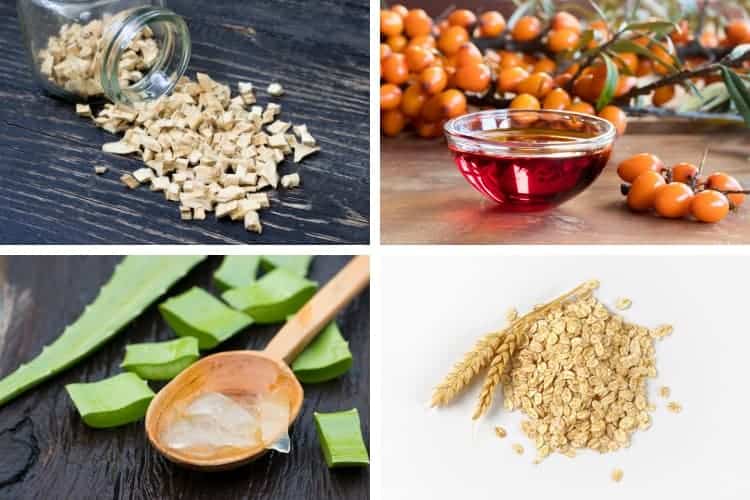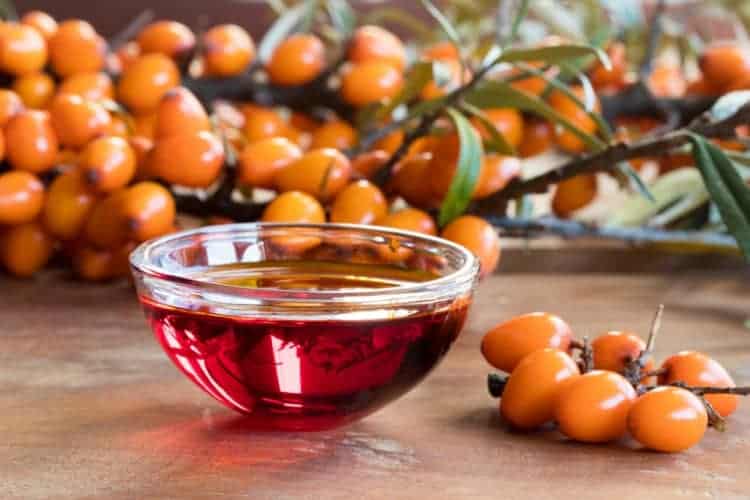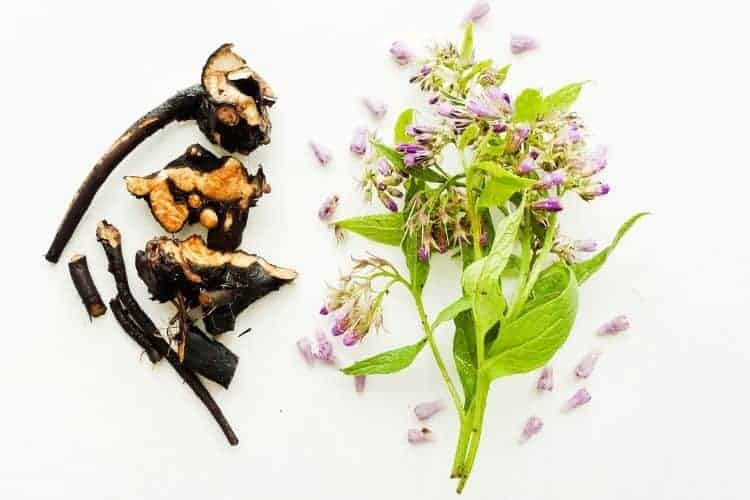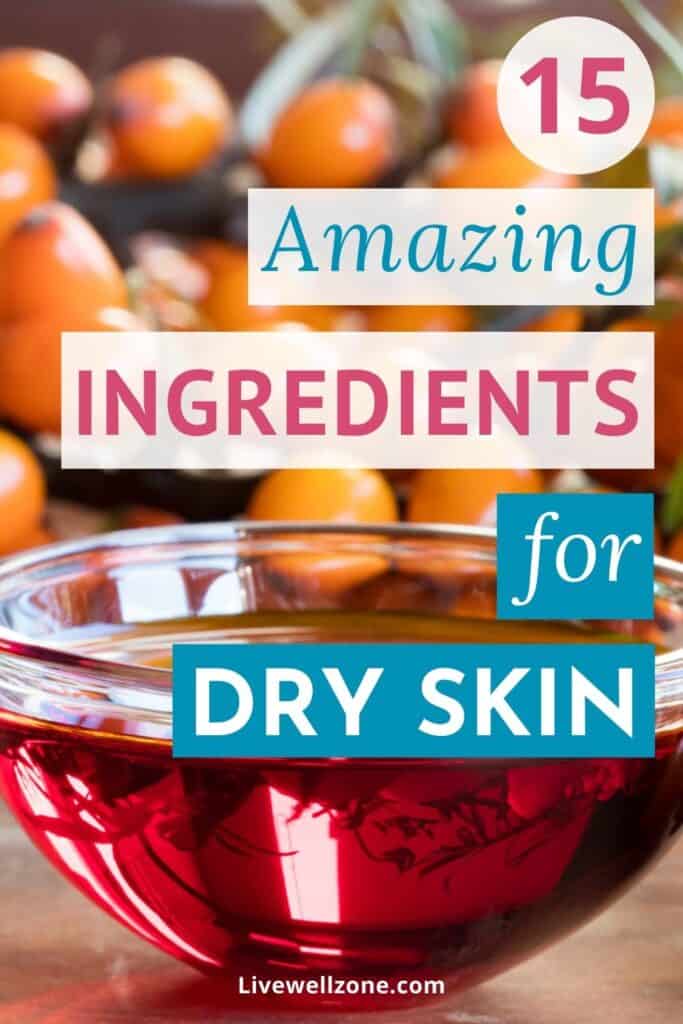
The best natural ingredients for dry skin on face fall into four main categories:
- Occlusives: these are ingredients that create a barrier on the skin and help to slow down the loss of water that is already in the skin.
- Hydrators and Humectants: these attract moisture to the skin or they can be naturally high in water and therefore, they’re the main source of water.
- Moisturizers: these soften the skin, giving it a soft and supple look (and feel).
- Anti-inflammatory Agents: dry skin is sometimes accompanied by inflammation that may show up in the form of redness, itching and other symptoms. So, it’s a good idea to have something that basically cools those inflammatory flames.
Please note that neither one of the above ingredient types is superior to the other. Rather, they should all be part of your skincare routine to help balance your skin
Now, let’s have a look at the natural ingredients that are great for improving dry skin.
15 NATURAL INGREDIENTS THAT ARE GOOD FOR DRY SKIN
1. Green Tea
Green tea is rich in antioxidants that are known for soothing the skin. In fact, the most studied green tea antioxidant – EGCG (epigallocatechin gallate) – is beneficial for sun-damaged skin and may even be helpful for severe dry skin conditions like psoriasis (source).
2. Marshmallow Root
Historically, marshmallow root has been used to soothe dry and itchy skin.
One of the main reasons why marshmallow has this historical use is because it produces mucilage, a gelatinous substance composed mainly of polysaccharides.
When applied to the skin, the mucilage helps to deeply moisturize the skin and leaves it feeling silky.
3. Sea Buckthorn Oil

One of the most notable things about sea buckthorn oil is that it has approximately 190 active ingredients, including:
- Essential fatty acids (especially omega-7, which is not as abundant in the plant kingdom as other omega fats).
- Vitamins such as A, B (B1, B2 and B6), C and E. The vitamin E, in particular, is great for moisturizing dry skin, while vitamins A and C acts as antioxidants.
Overall, research shows that sea buckthorn oil is helpful for hydrating the epidermis (the upper layer of skin) while also preventing water loss from the skin (source).
In addition, this oil maintains skin’s elasticity and can soothe inflammatory, dry conditions like eczema.
4. Oats
One of the main reasons why oats are a classic natural remedy for dry (and itchy skin) is because they’re rich in beta-glucans. These beta glucans are natural sugars that attract water to the skin, therefore helping the skin to stay hydrated.
In addition, oats work well as a scrub (without the abrasiveness of sugar or other granules).
If using oats in DIY recipes, it’s best to buy colloidal oatmeal (very finely ground oats). It’s much easier to work with and retains the skin softening vitamins, minerals, fats, proteins and other nutrients that make oats ideal for parched skin.
5. Borage Seed Oil
Borage oil is rich in essential fatty acids, particularly GLA (gamma linoleic acid) which is an omega 6 fatty acid.
Research indicates that borage oil can help with issues associated with dryness (such as eczema and rosacea).
In addition, borage oil has both antioxidant and anti-inflammatory properties. So, it can protect dry skin from further environmental damage, and also help dry skin bounce back from inflammation.
6. Comfrey Root and Leaves

Comfrey root is rich in polysaccharides, which are carbohydrates that help the skin to stay hydrated and supple (source).
In addition, comfrey is a natural source of allantoin, an anti-inflammatory compound that supports skin renewal (source).
7. Aloe Vera
The gel from the aloe vera plant is about 99% water. So, if your skin is in need of serious hydration, you simply can’t beat this!
Furthermore, aloe has various enzymes that gently exfoliate the skin, resulting in a softer, smoother and more supple texture.
And if your skin is not only dry, but also inflamed then you’ll be happy to know that aloe is very soothing for inflammatory conditions like eczema, rosacea and psoriasis.
8. Honey
Honey’s main claim to fame is that it is a humectant – meaning that it draws moisture to the skin. It’s also anti-inflammatory and antibacterial.
Thanks to its antibacterial properties, honey can even be used as a substitute for abrasive cleansers.
Furthermore, it can be used as a face mask and spot treatment for pimples.
9. Glycerin
Similar to honey, glycerin is also a humectant that attracts water to the skin.
In terms of its chemical composition, glycerin is a sugar alcohol that can be derived from animals, plants and petroleum.
Personally, I find vegetable glycerin – usually derived from soy, palm or coconut – to be ideal for all skincare needs.
NOTE: in the same way that glycerin draws moisture from the environment and into the skin, it can also do the opposite. So, if you live in a very dry area, be careful. You might have to use small amounts or skip it completely.
10. Jojoba Oil
Jojoba has one main benefit above all others oils: it more closely resembles our natural sebum. As such, it is compatible with all skin types, including dry skin.
In addition, jojoba is a good source of vitamin E, an antioxidant that is helpful for hydrating and soothing the skin (source).
Last but not least, the vitamin E in jojoba also helps to reinforce the skin’s natural barrier.
11. Avocado Oil
Avocado oil provides a host of nutrients, including beta-carotene, proteins, fatty acids and vitamins (notably A, D, E) that moisturize the skin, protect it from UV damage and may even promote wound healing.
NOTE: when buying avocado oil for your own DIY projects, make sure it’s unrefined. The unrefined type is very dark and stands in contrast to a lot of the lighter colored, “pure avocado oil” some retailers sell. The latter is actually refined and refined oils don’t provide the same nutritional/therapeutic benefits.
12. Rosehip Oil
Rosehip is a super gentle, easy-to absorb oil that is most known for being rich in vitamin C, vitamin A and fatty acids.
Not only is it great for dry skin, but it’s known to improve stretch marks, wrinkles, acne, redness and for soothing sensitive, inflamed skin.
13. Castor Oil
Castor oil is an occlusive, meaning that it forms a barrier on the skin, helping to slow down the rate of water loss from the skin. And the good thing is that unlike heavier occlusives (such as petroleum jelly), castor oil is lighter and also contains nutrients.
Some of those standout nutrients include vitamin E and a fatty acid known as ricinoleic acid. Ricinoleic acid is very moisturizing, in addition to having soothing and anti-inflammatory properties.
Interestingly enough, ricinoleic isn’t found in many other plants. So, that’s probably why nature put lots of it in the castor bean. In fact, about 90% of the fatty acids in castor oil is ricinoleic acid (source).
So, if struggle with extremely dry, cracked and peeling skin, then castor oil is one of the best home remedies to reach for.
14. Milk
We’ve all heard the legendary stories of a certain Egyptian queen bathing in milk. And there are other traditions, such as Ayurvedic Medicine, where milk is an integral part of various healing protocols.
The main reason why milk – specifically cow and goat’s milk – is helpful for dry skin is that it contains lactic acid.
Lactic acid is a natural exfoliant that facilitates the process of removing dead skin cells, so as to reveal healthier skin.
NOTE: if you’d rather skip animal milk, you can also try coconut milk and almond milk (though their constituents are different from cow and goat milk).
15. Kaolin Clay
If you want to venture into the world of clays, then kaolin is the most appropriate for dry skin. It’s far less drying compared to other clays while still offering all the great detoxifying benefits of clay.
The easiest way to use kaolin is to mix it with water until you get a smooth paste. Then apply the paste on your face as a mask.
If your skin is very dry, you might want to add a little bit of oil to the mix to balance out the dryness.
FAQs ABOUT NATURAL INGREDIENTS FOR EXTREMELY DRY SKIN
How can I treat dry skin on my face naturally?
Aside from using topical products that are humectants, hydrators, moisturizers or occlusives, it’s important to hydrate the body internally.
But please note that proper hydration isn’t just about drinking water. Having the right balance of minerals in your diet is what ensures that your body, and therefore your skin, stays hydrated.
To understand exactly how hydration works, be sure to read this article about how much water to drink for clear skin.
CONCLUSION
Whether you plan on making your own products or buy them, the ingredients we’ve covered in this article are great for soothing and improving dry skin.
As with all things skin-related, you may need to do some experimentation to find which one(s) work best for you.

You Might Also Enjoy:
Kaolin Clay Mask for Dry Skin: Benefits and Tips For A Healthy Glow
Natural Skin Care Routine For Dry Skin: A Complete Guide
5 Things To Know Before Using Clay for Dry Skin (+ Bonus Recipe)
Best Carrier Oils for Sensitive Skin: 10 Oils To Soothe Dryness, Acne, Cracked Skin & More

